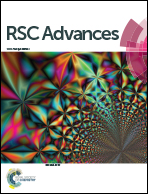Dual-enzymatically crosslinked and injectable hyaluronic acid hydrogels for potential application in tissue engineering†
Abstract
Recently, in situ formed injectable hydrogels have shown great potential in biomedical applications as therapeutic implants or carriers in tissue repair and regeneration. They can seal or fill the damaged tissue to function as cell/drug delivery vehicle perfectly through a minimally invasive surgical procedure. In this study, hyaluronic acid (HA) is functionalized with tyramine to produce an injectable hydrogel dual-enzymatically crosslinked by horseradish peroxidase (HRP) and galactose oxidase (GalOX). This new tyramine-modified HA (HT) hydrogel exhibited good injectability, favorable cytocompatibility to mice bone marrow mesenchymal stem cells (BMSCs), and low inflammatory response verified by cytotoxicity assay in vitro and an in situ subcutaneous injection study in vivo. In addition, the gelation time, swelling behavior, and degradation rate of the HT hydrogel could be adjusted through varying the concentrations of HT and GalOX in a certain range. These encouraging results suggest that such biocompatible HT hydrogels might have potential application in three-dimensional stem cell culture and tissue engineering.



 Please wait while we load your content...
Please wait while we load your content...